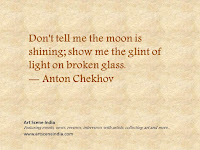Art is a visual investment, and as a medium has the ability to alter the aesthetics of the environment
Buying your first work of art can be intimidating and perhaps, also perplexing. How does one decide which artist’s work to buy or where to buy it from? Similarly, there are questions related to style, genre, medium, size and of course, the price of the artwork. These can all add further to the confusion. So, here are a few tips to guide you towards selecting and buying an artwork.
Empower yourself
The first step is to visit a few art galleries to see the works that are displayed there, and consider what engages you - which works do you feel aesthetically, emotionally and intellectually drawn to? Notice your reaction to the works displayed and this will give you an indication of the kind of works that you relate to. Visualize these on your walls now and consider if you would like to look at them over and over again. Remember that art is a long term investment and that is very unlikely that you would purchase a new work of art for your living room every couple of months.The next step is to look up online galleries and browse through images to learn more about various genres, styles and corresponding prices. Again, this will give you a sense of the kind of art which engages you, as well as direct you to artists whose works you like.
 Make sure, you do this only after you have visited and viewed art galleries, since the physicality of viewing art is an important step in understanding its nuances, for instance the tactility of the medium, use of pigments and materials, textural quality and the dimensionality of the artwork are evident only when you stand before it. In fact, also visit artist studios and interact with artists whenever possible. This will facilitate an understanding of processes, and materials and media.
Make sure, you do this only after you have visited and viewed art galleries, since the physicality of viewing art is an important step in understanding its nuances, for instance the tactility of the medium, use of pigments and materials, textural quality and the dimensionality of the artwork are evident only when you stand before it. In fact, also visit artist studios and interact with artists whenever possible. This will facilitate an understanding of processes, and materials and media. In parallel, read up on articles to know more about artists and current exhibitions. It will give you a sense of art trends, popular artists and will cultivate familiarity with the language used in describing art. This will also help you in understanding text accompanying art, which in turn offers insights into the work.
Set a budget
It is important to set aside a budget for art so that there is clarity on the amount that you are willing to invest in art. It would be advisable to begin with a small amount, perhaps in the Rs 20,000 - 50,000 range, which allows you to gain confidence in the initial period of learning. You could consider buying works by upcoming artists as these are likely to be in the affordable range. You could also purchase limited edition prints, drawings and watercolours, which are generally priced lower, in comparison to oils and acrylics.
Following these steps will ensure you learn about art and the art market, enabling you to make the right choices when it comes to buying for your home. Even if you are buying art at your interior decorator’s advice, take the time to be personally involved.
Art is a visual medium of expression, which can be used creatively to complement home interiors. It is a visual investment, and as a medium has the ability to alter the aesthetics of the environment completely and as you learn more about its finer aspects, you can incorporate both style and substance in your home interiors.
Related posts,
Following these steps will ensure you learn about art and the art market, enabling you to make the right choices when it comes to buying for your home. Even if you are buying art at your interior decorator’s advice, take the time to be personally involved.
Art is a visual medium of expression, which can be used creatively to complement home interiors. It is a visual investment, and as a medium has the ability to alter the aesthetics of the environment completely and as you learn more about its finer aspects, you can incorporate both style and substance in your home interiors.
Related posts,
- TIPS: 10 Tips For Buying Art
- ART COLLECTION: Chitrakala Parishath, Bangalore
- ART COLLECTION: Jaganmohan Palace, Mysore
- ART COLLECTION: NGMA, Bangalore









